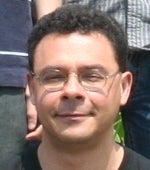
Luis Ibáñez works as Senior Software Engineer at Google Inc in Chicago. Opinions expressed in this site are his own.You can find him in github at: http://www.github.com/luisibanezand in twitter at: http://www.twitter.com/luisibanezHe previously worked as a Technical Leader at Kitware Inc., and Director of Open Source Community Development at the Open Source EHR Agent (OSEHRA). At Kitware he was closely involved in the development of open source software for medical imaging applications, in particular, working with the Insight Toolkit (ITK).Luis is a strong supporter of Open Access, and one of the editors of the Insight Journal, an OA Journal that enforces the verification of reproducibility. In collaboration with other instructors, Luis taught a course on Open Source Software Practices at RPI between 2007 and 2013, and also at the State University of New York at Albany between 2011 and 2014.Luis Ibáñez received a B.S. in Physics from the Universidad Industrial de Santander (Bucaramanga, Colombia) in 1989 and a M.S. in Optics from the same university in 1994. He received a D.E.A and Ph.D. degrees from the Universite de Rennes I (Rennes, France) in 1995 and 2000, respectively. In 1999, Luis Ibáñez joined the Division of Neurosurgery of the University of North Carolina at Chapel Hill and participated as a member of the MIDAG and CADDLab groups. His work at UNC was related to the development of algorithms for 2 and 3D registration applied to image guided surgery. He also participated as developer of the INSIGHT Registration and Segmentation Toolkit sponsored by the National Library of Medicine. Luis Ibáñez joined Kitware, Inc. in February 2002 where he was one of the main developers of the Insight Toolkit (ITK) coordinating its maintenance with other developers and the user community; he is also one of the main developers of the Image Guided Surgery Toolkit (IGSTK) and participated in crafting the operational principles of the Insight Journal. Luis Ibáñez is a strong supporter of Open Access, and the verification of reproducibility in scientific publications and is a regular speaker in ITK training courses, and in events disseminating the principles of Open Source. In August 2014, Luis joined Google Inc as Software Engineer, to work with the corporate engineering team in New York city.

Authored Comments
Yes zoobab,
You are right on the first account,
The action of writing code does not infringe on Patents.
Unfortunately, you are not correct on the second account.
Strictly speaking, one "should search for prior art".
But...in practice, there are so many patents, they are so general and are written in such a convoluted manner, that searching for prior art, even when done with the best of intentions, is a futile exercise.
Note that the action of compiling and linking an executable, and combining it with a computer, (under the current legal precedents) can infringe on a Patent.
Patents provide an exclusive Monopoly on the rights to:
* Use
* Make
* Sell
* Offer for Sale
* Import
an invention that is
* Novel
* Non-Obvious
* Useful
Rulings for the Court of Appeals of the Federal Circuit have made the interpretation that the combination of software with a general purpose computer results in a special purpose machine, and through that reasoning, they have made out of software a patentable subject matter.
The solution on that front is for the US Supreme Court to intervene or for Congress to clarify. Since Congress never approved Software as Patentable subject matter (nor Business models BTW).
In the meantime, the best that we mere mortal, ordinary citizens can do is to write these 2-pages Defensive Publications, to prevent obvious fields from being removed from the public domain by upcoming Patents.
Once a Patent has been awarded, it is quite expensive to make it invalid. It is possible, but it demands time and dedication, hence resources.
It is much easier to work in advance on Defensive Publications, because they made it into the database that patent examiners must search when looking for Prior Art.